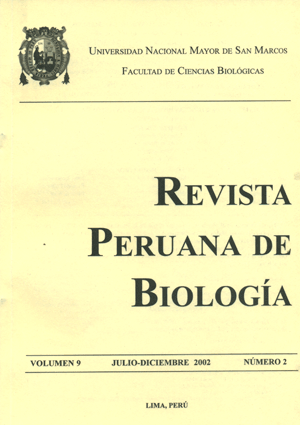Natural and anthropogenic processes associated to scallops mortality in Paracas bay (Pisco, Peru) in june 2000
DOI:
https://doi.org/10.15381/rpb.v9i2.2528Keywords:
Marine pollution, fishery effluents, mortality, Argopecten purpuratus, Pisco, PeruAbstract
With the aim to determine the processes which generated the scallop (Argopecten purpuratus) mortality event on June 6, 2000, natural and anthropogenic environmental conditions in Paracas bay (Pisco, Per˙) during a period of fishery industrial activity were analysed between May 17 and June 13, 2000. Daily surveys of oceanographic variables such as temperature, oxygen, phytoplankton volume and aquatic quality variables such as oil and greases, total suspended solids, BOD5 , pH, sulphurs and thermotolerant coliforms, were carried out in 5 stations inside Paracas bay. Since mid of May, high contents of oil and greases coming from fishery effluents were detected. At the end of May, the presence of a red tide was observed associated with an increase in total suspended solids, pH and dissolved oxygen, especially off Atenas and El Chaco. Beginning June in surface waters, a reduction in total suspended solids (< 25 mg.L-1) and oxygen (< 3 mL.L-1) was produced, reaching a maximum the oil and greases (max: 10,1 mg.L-1), while in bottom waters the process of accumulation of organic matter produced an anoxic state with high sulphurs content (max: 19,73 µgat.L-1). These conditions reduced the quality of the marine environment, producing the mortality of the benthic organisms. The input of organic matter coming from fishery effluents, together with the input coming from the harmful algal bloom, generated a synergic effect on the quality of the water column and the sediments producing the mortality of benthic species, among them, the scallops.Downloads
Downloads
Published
Issue
Section
License
Copyright (c) 2002 Rita Cabello, Jorge Tam, Maria Elena Jacinto

This work is licensed under a Creative Commons Attribution-NonCommercial-ShareAlike 4.0 International License.
AUTHORS RETAIN THEIR RIGHTS:
a. Authors retain their trade mark rights and patent, and also on any process or procedure described in the article.
b. Authors retain their right to share, copy, distribute, perform and publicly communicate their article (eg, to place their article in an institutional repository or publish it in a book), with an acknowledgment of its initial publication in the Revista Peruana de Biologia.
c. Authors retain theirs right to make a subsequent publication of their work, to use the article or any part thereof (eg a compilation of his papers, lecture notes, thesis, or a book), always indicating its initial publication in the Revista Peruana de Biologia (the originator of the work, journal, volume, number and date).






